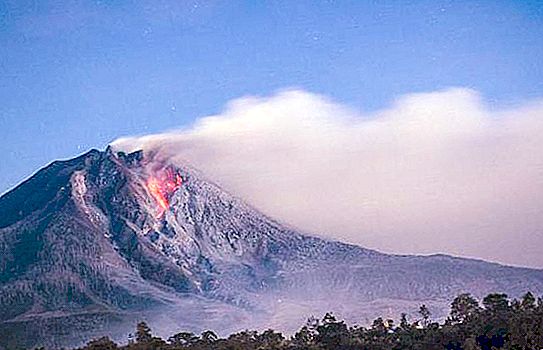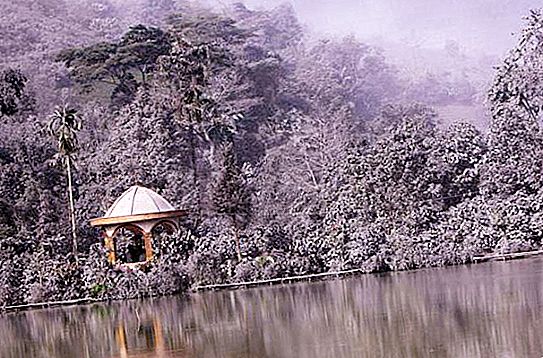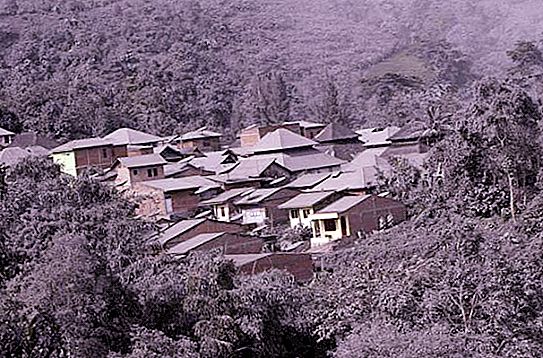The largest cluster of volcanoes is located in the "belt of fire" of the Earth - the Pacific volcanic ring. It was here that 90% of all earthquakes in the world occurred. The so-called fire belt stretches along the entire perimeter of the Pacific Ocean. In the west along the coast from the Kamchatka Peninsula to New Zealand and Antarctica, and in the east, passing through the Andes and the Cordillera, reaches the Aleutian Islands of Alaska.
One of the current centers of the "fire belt" is located in the north of the island of Sumatra in Indonesia - Sinabung volcano. This one of the 130 volcanoes in Sumatra is notable for the fact that over the past seven years it has been constantly active and attracts the attention of scientists and the media.
Chronicle of the Sinabung
The first eruption of the Indonesian Sinabung volcano after four centuries of sleep began in 2010. On the weekend of August 28 and 29, an underground rumble and a rumble were heard. Many residents, about 10, 000 people, fled away from the awakened volcano.
On Sunday night, the Sinabung volcano woke up completely: the eruption began with a powerful emission of a column of ash and smoke more than 1.5 km up. After the explosion on Sunday followed by a more powerful on Monday, August 30, 2010. The eruption claimed the lives of two people. In total, about 30, 000 surrounding residents were forced to leave their homes and fields covered with volcanic ash with a dead crop. In the photo below, residents run away from a cloud of ash.

The second eruption of Sinabung volcano began on November 6, 2013 and then lasted several more days. The volcano threw ash pillars to a height of 3 km, a train from which spread tens of kilometers. More than 5, 000 people from 7 surrounding villages were evacuated. The government of Sumatra urged not to approach the Sinabung volcano for more than 3 km.
In February 2014 there was a disaster. After the cessation of volcanic activity (in early January), evacuated residents of villages located more than 5 km from the volcano were allowed to return home. But immediately after that, on February 1, a powerful lava surge and pyroclastic flow killed 16 people.

And until now, the Sinabung volcano has not calmed down: a column of ash and smoke is visible for many kilometers, eruptions of varying strength and duration do not stop and take the lives of daredevils who risked returning to the exclusion zone of the volcano with a radius of 7 km, which was organized by the Sumatra government after the disaster in 2014.
It is noteworthy that in the exclusion zone you can meet entire cities and ghost villages, crumbling, empty, as if an apocalypse had already overtaken the Earth. But there are also brave farmers who continue to live at the foot of the Sinabung volcano. What attracts them so much?
Why do people settle at the foot of volcanoes
The soil on the slopes of volcanoes is extremely fertile due to the minerals that fall into it with volcanic ash. In a warm climate, you can grow more than one crop per year. Therefore, the farmers of Sumatra, despite the dangerous proximity of the Sinabung volcano, do not leave houses and arable land at its foot.
In addition to agriculture, they mine gold, diamonds, ore, volcanic tuff and other minerals.
What is dangerous volcanic eruption
Among people who do not live in geologically active areas, there is a cliche that the eruption of a volcano is associated exclusively with the flow of lava, which rushes along the side of the mountain. And if a person was lucky to be or settle and plant a crop on its opposite side, then the danger was over. Otherwise, you just need to climb higher on a rock or swim on a stone fragment in the middle of lava, like on an ice floe in water, the main thing is not to fall down. And it’s better to run across to the right side of the mountain in time and wait an hour or two.
Lava is certainly deadly. Like the earthquake that accompanies a volcanic eruption. But the stream moves rather slowly, and a physically full-fledged person is able to leave him. An earthquake is also not always of great magnitude.
In fact, pyroclastic flows and volcanic ash pose a great danger.
Pyroclastic flows
The hot gas that escapes from the bowels of the volcano picks up stones and ashes and sweeps everything in its path, rushing down. Such flows reach speeds of 700 km / h. For example, you can imagine the Sapsan train at full speed. Its speed is about three times less, but despite this, the picture is quite impressive. The temperature of the gases in the rushing mass reaches 1000 degrees, it can burn all life on the way in a matter of minutes.
One of the deadliest pyroclastic flows known in history killed 28, 000 people at once (according to some sources, up to 40, 000 people) in the port of Saint-Pierre on the island of Martinique. On May 8, 1902, in the morning, the Mont-Pelet volcano, at the foot of which the port was located, after a series of monstrous explosions threw out a cloud of hot gas and ash, which reached the village in a matter of minutes. A pyroclastic stream swept through the city at a frantic speed, and there was no escape even on the water, which instantly boiled and killed everyone who fell into it from overturned ships in the harbor. Only one ship managed to get out of the bay.
In February 2014, 14 people died in this stream during the eruption of the Indonesian volcano Sinabung.
Volcanic ash
At the time of the eruption, ashes and rather large stones ejected by the volcano can burn or cause injury. If we talk about ash, which covers everything around after the eruption, then its consequences are more long-lasting. In his own way, he is even beautiful - the post-apocalyptic landscape from the island of Sumatra in the photo below is confirmation of this.

But ashes are bad for the health of people and pets. Without a respirator, walking in such a place for a long time is deadly. Ashes are also very heavy and, especially when mixed with rainwater, can break through the roof of a house, dropping it on those inside.
In addition, in large quantities it is destructive for agriculture.
Cars, airplanes, water treatment plants, even communication systems - everything fails under a layer of ash, which also indirectly poses a danger to people's lives.





